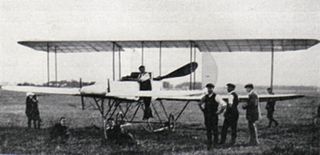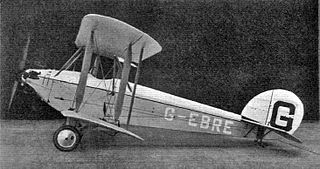
The AD Flying Boat was designed by the British Admiralty's Air Department to serve as a patrol aircraft that could operate in conjunction with Royal Navy warships. Intended for use during the First World War, production of the aircraft was terminated as the end of the war came into sight, and the type saw little operational use. A number were repurchased after the end of the war by Supermarine Aviation and rebuilt as civil transports, becoming known as the Supermarine Channel.

The Handley Page H.P.42 and H.P.45 were four-engine biplane airliners designed and manufactured by British aviation company Handley Page, based in Radlett, Hertfordshire. It held the distinction of being the largest airliner in regular use in the world upon the type's introduction in 1931.

The Blackburn Iris was a British three-engined biplane flying boat of the 1920s. Although only five Irises were built, it was used as a long-range maritime reconnaissance aircraft by the Royal Air Force, where it equipped a squadron for four years, being used to carry out a number of notable long-distance flights. The final version of the Iris, the Iris Mark V was developed into the aircraft that replaced it in Squadron service, the Blackburn Perth.

The S.E.1 was an experimental aircraft built at the Army Balloon Factory at Farnborough in 1911. Its place in aviation history is mainly that it was the first in the series of Royal Aircraft Factory designs - several of which played an important role in World War I.

The Roe I Biplane was the first powered aircraft to be designed, built, and flown in England. Designed in an attempt to claim a prize offered by the Brooklands Automobile Racing Club, it was designed and built by Alliott Verdon Roe, who based it on a powered model with which he had won a Daily Mail prize of £75 at Alexandra Palace in April 1907. This prize was substantially larger: the club committee was offering £2,500 for the first person to fly a circuit of their three-mile (4.8 km) race track by the end of the year. In addition the Daily Graphic was offering a £1,000 prize for a flight of more than a mile (1.6 km).

The Roe I Triplane was an early aircraft designed and built by A.V. Roe which was the first all-British aircraft to fly..

The Blackburn L.1 Bluebird was a British single-engine biplane light trainer/tourer with side-by-side seating, built in small numbers by Blackburn Aircraft in the 1920s.

The Curtiss Models F made up a family of early flying boats developed in the United States in the years leading up to World War I. Widely produced, Model Fs saw service with the United States Navy under the designations C-2 through C-5, later reclassified to AB-2 through AB-5. Several examples were exported to Russia, and the type was built under license in Italy.

The Norman Thompson N.T.4 was a twin-engined British flying boat of the First World War. Although less well known than similar Curtiss and Felixstowe flying boats, 50 were ordered for Britain's Royal Naval Air Service.
De Havilland Biplane No. 1 is a name applied retrospectively to the first aircraft constructed by Geoffrey de Havilland, who built and flew it once in December 1909. De Havilland undertook the project with the assistance of his friend, and soon to be brother-in-law, Frank Hearle, and financed the project with £1,000 borrowed from his maternal grandfather as an advance on his inheritance.

The Supermarine Commercial Amphibian was a passenger-carrying flying boat. The first aircraft to be designed by Supermarine's Reginald Mitchell, it was built at the company's works at Woolston, Southampton, for an Air Ministry competition that took place during September 1920. Based on the Supermarine Channel, the Amphibian was a biplane flying boat with a single engine, a wooden hull, unequal wingspans and a 350 horsepower (260 kW) Rolls-Royce Eagle engine. The pilot sat in an open cockpit behind two passengers.

The Supermarine Nanok was a British three-engined biplane flying boat built by Supermarine. Built to meet a Royal Danish Navy requirement, the single prototype was rebuilt as a private air yacht and renamed the Supermarine Solent.

The Supermarine Seal II was a British flying boat developed by Supermarine after it secured a British Air Ministry order for a prototype three-seater fleet spotter amphibian. The prototype, which had to be capable of landing on Royal Air Force (RAF) aircraft carriers, was designed by Supermarine's R.J. Mitchell, who incorporated suggestions made after the Supermarine Commercial Amphibian achieved second place after it was entered for an Air Ministry competition in 1920.

The Blackburn Pellet was a single-engined, single-seater biplane flying boat designed as a contender for the 1923 Schneider Trophy competition. It was destroyed while taking off for the trials of the contest.

The Boeing Model 6D, a.k.a. Boeing Model 6E, Boeing B-1D and Boeing B-1E, was an American pusher biplane flying-boat built by Boeing between 1928 and 1929.

The Bristol Scout E and F were a British single-seat biplane fighters built in 1916 to use newer and more powerful engines. It was initially powered by the Sunbeam Arab, but the third prototype was used as a testbed for the Cosmos Mercury, marking the start of Roy Fedden's association with the Bristol Aeroplane Company. The Armistice ended hopes of production.

The Boeing XPB was an American twin-engined biplane long-range patrol flying boat of the 1920s. A single example was built for the United States Navy.
The Sage Type 4 was a prototype British floatplane of the First World War. It was a designed as a two-seat reconnaissance aircraft for the Royal Naval Air Service, but was chosen for service as a floatplane trainer, although the end of the war resulted in production being cancelled.
The Bristol P.B.8, or Bristol-Coanda P.B.8', was an early British-built, Romanian-designed two-seat biplane trainer made by the Bristol Aeroplane Company in 1914. Only one was completed, which was never flown.

The pioneer era of aviation was the period of aviation history between the first successful powered flight, generally accepted to have been made by the Wright Brothers on 17 December 1903, and the outbreak of the First World War in August 1914.

















